Your Computer device is infected with an adware or malware causing you to see this popup.
This may happen due to obsolete virus or corrupted system files.
To fix, please call system support at 1-844-841-0435 immediately. Please ensure you do not restart your Computer device to prevent data loss....
Did you get this kind of popup when using your computer? This article will teach you how to remove it.
Know More about Dangerousviruses.com Popup
Once you are seeing popup from dangerousviruses.com asking you to call a certain number to fix the problem, you might get into a tech support scam. Cyber criminals often use some adware or malware to display this kind of popup and offer a scam number to obtain money from innocent users. Please don’t get cheated.
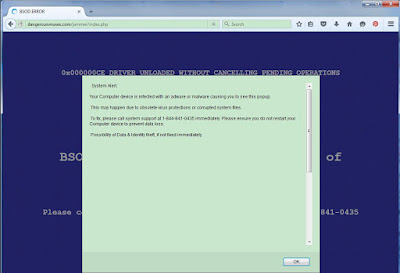
Dangerousviruses.com Popup usually appears after you download suspected software to your computer or visit questionable sites. Once inside, this popup will pop up to your Internet Explorer, Mozilla Firefox, or Google Chrome without your permission. It can even freeze your browser at this fake bsod domain to force you call the number. Even if you exit by ending malicious process from Task Manager or restarting your computer, you will get trapped by this popup over and over. It is a severe trouble that you should be concerned with.
Once you are troubled by this annoying fake bsod popup, you can refer to the methods below to get rid of it and clear away all the potential threats.
Method 1: Manually Remove Dangerousviruses.com Fake Bsod Popup
Method 2: Automatically Get Rid of Dangerousviruses.com Fake Bsod Popup with SpyHunter
Step 1. Press Ctrl+Alt+Del keys together and stop Dangerousviruses.com Fake Bsod Popup or browser processes in the Windows Task Manager.
* end the one related to the PUP
* you should end the one to the infected browser (e.g. chrome.exe) if your browser is frozen/locked.
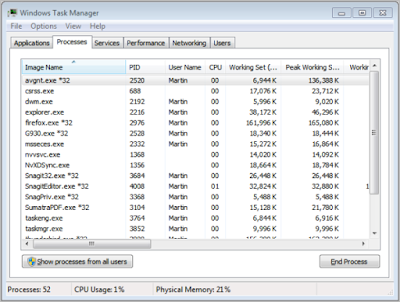
Step 2. Uninstall PUP about Dangerousviruses.com Fake Bsod Popup from Control Panel
For Windows Vista and Windows 7
1. Press the “Start” button.
2. Select “Control Panel” from the menu.
3. Choose “Programs & Features”.
4. Find “PUP about Dangerousviruses.com Fake Bsod Popup” in the list of installed programs.
5. Select it and press “Uninstall” or right-click the program and select Uninstall.
For Windows XP and other Windows operating systems
1. Press the “Start” button.
2. Select “Control Panel” from the menu.
3. In the Control Panel, select “Add/Remove Programs”.
4. Find “PUP about Dangerousviruses.com Fake Bsod Popup” in the list of installed programs.
5. Select it and press “Uninstall”.
(Optional Step) Reset Internet Explorer by the following guide (take IE as an example):
Open Internet Explorer >> Click on Tools >> Click on Internet Options >> In the Internet Options window click on the Connections tab >> Then click on the LAN settings button>> Uncheck the check box labeled “Use a proxy server for your LAN” under the Proxy Server section and press OK.
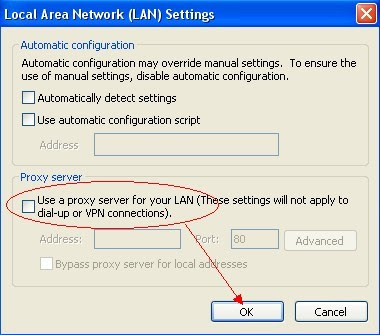
Move to Search Providers >> select items related to Dangerousviruses.com Fake Bsod Popup and remove it.
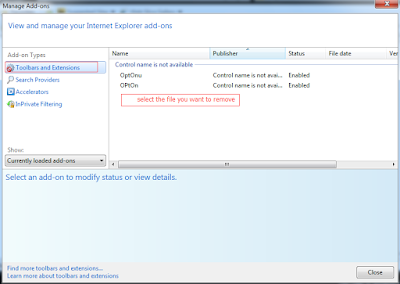
Go to Customize and control Google Chrome (top right menu)
>> Tools/Settings >> Extension >> Remove suspicious
extensions
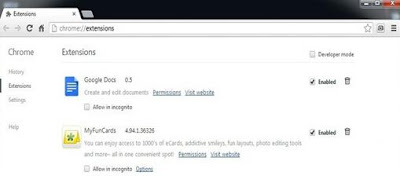 Reset your settings on On startup >> Set pages, Appearance >> Change, and Search >> Manage search engines...
Reset your settings on On startup >> Set pages, Appearance >> Change, and Search >> Manage search engines...

Mozilla Firefox
Open menu >> Add-on >> remove items related to Dangerousviruses.com Fake Bsod Popup

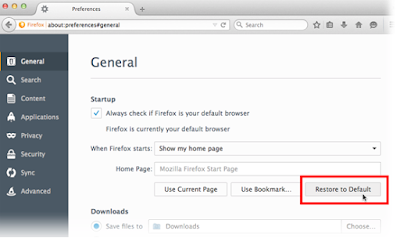
Step 4. Restore home page and clear all the cookies of your affected web browsers.
Since the tricky virus has the ability to use cookies for tracing and tracking the internet activity of users, it is suggested users to delete all the cookies before a complete removal.
Google Chrome:
Mozilla Firefox:
Internet Explorer:
Step 5. Show all hidden files and clean all the malicious files.
(1).Click the Start button and choose Control Panel, clicking Appearance and Personalization, to find Folder Options then double-click on it.
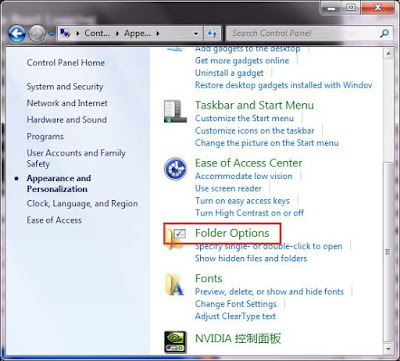
(2).In the pop-up dialog box, click the View tab and uncheck Hide protected operating system files (Recommended).
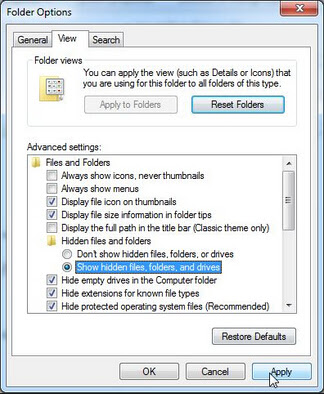
(3). Clean all the malicious files about this infection as below.
%AllUsersProfile%\{random.exe\
%AllUsersProfile%\Application Data\
%AllUsersProfile%\random.exe
%AppData%\Roaming\Microsoft\Windows\Templates\random.exe
%Temp%\random.exe
%AllUsersProfile%\Application Data\random
Step 6. Delete related malicious registry entries.
Open Registry Editor by pressing Window+R keys together.(another way is clicking on the Start button and choosing Run option, then typing into Regedit and pressing Enter. )
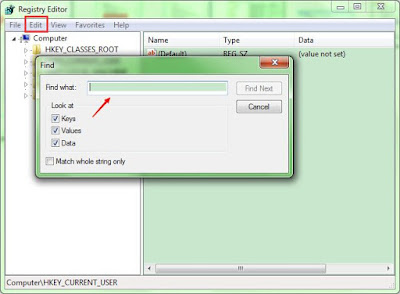
Delete all the vicious registries as below:
HKEY_LOCAL_MACHINE\SOFTWARE\<random>Software
HKEY_LOCAL_MACHINE\SOFTWARE\supWPM
HKEY_LOCAL_MACHINE\SYSTEM\CurrentControlSet\Services\Wpm
HKEY_CURRENT_USER\Software\Microsoft\Internet Explorer\Main "Default_Page_URL" =
"http://www.<random>.com/?type=hp&ts=<timestamp>&from=tugs&uid=<hard drive id>"
SpyHunter is powerful anti-spyware/malware application. It is created to help inexperience computer users to get rid of nasty and stubborn malware including adware, browser hijacker, trojan, worm and may other viruses. There are many features in SpyHunter. You will never regret to remove malware and protect your PC with this application.
You can click the icon below to get SpyHunter.
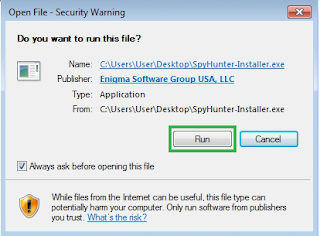
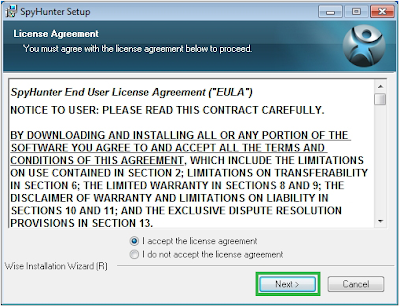
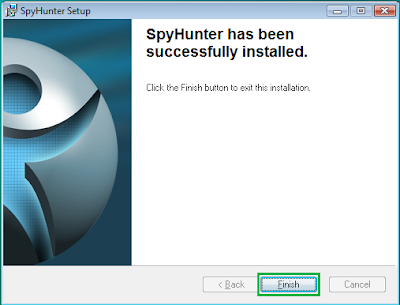
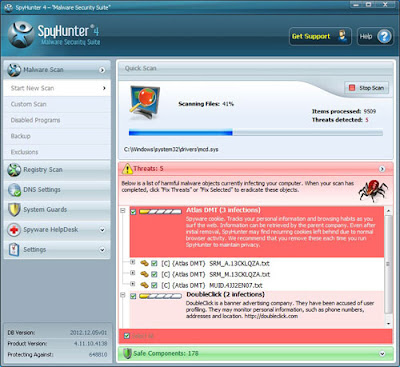

If you find some registry errors, such as dll file errors in your computer, Regcure Pro will be a good choice to quickly and powerfully clean your windows registry and protect your system files.
Final Tip:
Dangerousviruses.com Fake Bsod Popup can cause a lot of troubles. Usually, the manual tips above may help your get rid of it. But if you fail, you can download powerful remover to get rid of it.
Easy Methods to Remove Dangerousviruses.com (1-844-841-0435) Fake BSOD Popup
Once you are troubled by this annoying fake bsod popup, you can refer to the methods below to get rid of it and clear away all the potential threats.
Method 1: Manually Remove Dangerousviruses.com Fake Bsod Popup
Method 2: Automatically Get Rid of Dangerousviruses.com Fake Bsod Popup with SpyHunter
Method 1: Manually Remove Dangerousviruses.com Fake Bsod Popup
Step 1. Press Ctrl+Alt+Del keys together and stop Dangerousviruses.com Fake Bsod Popup or browser processes in the Windows Task Manager.
* end the one related to the PUP
* you should end the one to the infected browser (e.g. chrome.exe) if your browser is frozen/locked.

Step 2. Uninstall PUP about Dangerousviruses.com Fake Bsod Popup from Control Panel
For Windows Vista and Windows 7
1. Press the “Start” button.
2. Select “Control Panel” from the menu.
3. Choose “Programs & Features”.
4. Find “PUP about Dangerousviruses.com Fake Bsod Popup” in the list of installed programs.
5. Select it and press “Uninstall” or right-click the program and select Uninstall.
For Windows XP and other Windows operating systems
1. Press the “Start” button.
2. Select “Control Panel” from the menu.
3. In the Control Panel, select “Add/Remove Programs”.
4. Find “PUP about Dangerousviruses.com Fake Bsod Popup” in the list of installed programs.
5. Select it and press “Uninstall”.
(Optional Step) Reset Internet Explorer by the following guide (take IE as an example):
Open Internet Explorer >> Click on Tools >> Click on Internet Options >> In the Internet Options window click on the Connections tab >> Then click on the LAN settings button>> Uncheck the check box labeled “Use a proxy server for your LAN” under the Proxy Server section and press OK.

Step 3. Remove unwanted add-ons from web browser.
Internet Explorer
Go to Tools >> Manage add-ons >> Toolbars and Extensions >> Remove items related to Dangerousviruses.com Fake Bsod Popup.Move to Search Providers >> select items related to Dangerousviruses.com Fake Bsod Popup and remove it.

Google Chrome


Mozilla Firefox
Open menu >> Add-on >> remove items related to Dangerousviruses.com Fake Bsod Popup

From Menu >> Option >> General. You can rewrite your home page URL or Restore to Default

Step 4. Restore home page and clear all the cookies of your affected web browsers.
Since the tricky virus has the ability to use cookies for tracing and tracking the internet activity of users, it is suggested users to delete all the cookies before a complete removal.
Google Chrome:
- Click on the "Tools" menu and select "Options"
- Click the "Under the Bonnet" tab, locate the "Privacy" section and Click the "Clear browsing data" button.
- Select "Delete cookies and other site data" and clean up all cookies from the list.
Mozilla Firefox:
- Click on Tools, then Options, select Privacy
- Click "Remove individual cookies"
- In the Cookies panel, click on "Show Cookies"
- To remove a single cookie click on the entry in the list and click on the "Remove Cookie button"
- To remove all cookies click on the "Remove All Cookies button"
Internet Explorer:
- Open Internet explorer window
- Click the "Tools" button
- Point to "safety" and then click "delete browsing history"
- Tick the "cookies" box and then click “delete”
Step 5. Show all hidden files and clean all the malicious files.
(1).Click the Start button and choose Control Panel, clicking Appearance and Personalization, to find Folder Options then double-click on it.

(2).In the pop-up dialog box, click the View tab and uncheck Hide protected operating system files (Recommended).

(3). Clean all the malicious files about this infection as below.
%AllUsersProfile%\{random.exe\
%AllUsersProfile%\Application Data\
%AllUsersProfile%\random.exe
%AppData%\Roaming\Microsoft\Windows\Templates\random.exe
%Temp%\random.exe
%AllUsersProfile%\Application Data\random
Step 6. Delete related malicious registry entries.
Open Registry Editor by pressing Window+R keys together.(another way is clicking on the Start button and choosing Run option, then typing into Regedit and pressing Enter. )

Delete all the vicious registries as below:
HKEY_LOCAL_MACHINE\SOFTWARE\<random>Software
HKEY_LOCAL_MACHINE\SOFTWARE\supWPM
HKEY_LOCAL_MACHINE\SYSTEM\CurrentControlSet\Services\Wpm
HKEY_CURRENT_USER\Software\Microsoft\Internet Explorer\Main "Default_Page_URL" =
"http://www.<random>.com/?type=hp&ts=<timestamp>&from=tugs&uid=<hard drive id>"
Method 2: Get Rid of Dangerousviruses.com Fake Bsod Popup with SpyHunter
SpyHunter is powerful anti-spyware/malware application. It is created to help inexperience computer users to get rid of nasty and stubborn malware including adware, browser hijacker, trojan, worm and may other viruses. There are many features in SpyHunter. You will never regret to remove malware and protect your PC with this application.
You can click the icon below to get SpyHunter.
This
real-time malware protection and removal tool offers free malware
scanner. You can buy the removal service to get rid of all the PC
threats detected by it. It has powerful features that other free
antivirus cannot offer.





Optional Suggestion: Regcure Pro - a wonderful Registry Cleaner
If you find some registry errors, such as dll file errors in your computer, Regcure Pro will be a good choice to quickly and powerfully clean your windows registry and protect your system files.
(Reference) Watch Relevant Video to Remove Dangerousviruses.com Fake Bsod Popup
Final Tip:
Dangerousviruses.com Fake Bsod Popup can cause a lot of troubles. Usually, the manual tips above may help your get rid of it. But if you fail, you can download powerful remover to get rid of it.

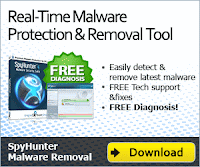

ReplyDeleteAre you willing to know who your spouse really is, if your spouse is cheating just contact cybergoldenhacker he is good at hacking into cell phones,changing school grades and many more this great hacker has also worked for me and i got results of spouse whats-app messages,call logs, text messages, viber,kik, Facebook, emails. deleted text messages and many more this hacker is very fast cheap and affordable he has never disappointed me for once contact him if you have any form of hacking problem am sure he will help you THANK YOU.
contact: cybergoldenhacker at gmail dot com